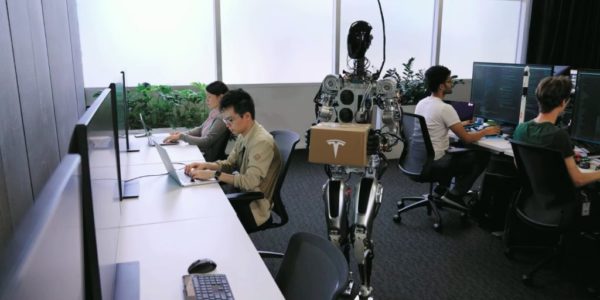Tesla showed off their new Optimus humanoid robot recently. We responded to it from the point of view of people using industrial automation, admiring robot development, and contemplating how future developments might affect our use of robots at work and perhaps even at home. Slate took a different tack.
The essay by Yulia Frumer suggests that the kind of humanoid robots people keep designing (they hark back to Japanese designs from 40 years ago) actually tell us more about what we think of human service workers than about robots and the future.
Why even think about humanoid robots?
Industrial robots do clearly defined, concrete tasks. if they need to move an item from one place to another, they can consist of a big arm with a grasping device of some kind and the ability to move the item from point A to point B.
They take on dull, dirty, dangerous jobs that require strength, precision, and speed beyond what a human can offer. Nobody cares if they are cute or friendly or agile. Certainly nobody wishes they looked more like people, ro that they could be “buddies,” as Elon Musk promised Optimus will be.
But when service workers began to be in short supply and the idea of replacing them with robots took hold, ideas about what robots should be like changed.
Retail robots were an early example of a non-industrial service robot. They were given googly eyes. Robot waiters (or more often, waitresses) and nurses were given shapes like skirts and pinafores. Hotel robots were built to interact with humans while actual human workers did the actual work.
“Robots reveal what we expect of those who serve us and where these expectations come from,” said Frumer. “Robots are not modeled on a ‘generic’ human being, but on a specific kind of human who provides a specific kind of labor. Robotic design, in other words, doesn’t just reflect the tasks we would like the robot to do, but the kind of human we would expect to do them. Design details of a given humanoid robot reveal hints about the kind of human worker engineers imagined (even unconsciously) as a model. These design details can tell us a lot about perceptions of the actual people associated with a particular labor, as well as tacit assumptions about status and identity. Most importantly, the design of humanoid robots reveals something of how we feel about service laborers and how we believe they ‘should’ behave.”
Girl Friday?
If engineers design humanoid robots to be cute, perky, and deferential, it’s because we want service workers to be cute, perky, and deferential, Frumer claims.
Some humanoid robots, including Optimus, says Frumer, are designed to be strong, muscular, uncomplaining workers. Frumer sees the possibility of racial stereotypes as well as gender stereotypes coming into play here.
“I am not afraid that robots will take over the world,” the essay concludes. “But I am afraid that robots like Optimus will eventually bring harm to humans. They will do so not by injuring humans physically, but … without mindful attention to design, humanoid robots will inevitably reinforce harmful associations attached to race, gender, and subservient labor, and thus exacerbate the discrimination and exploitation of human beings.”
A philosophical point, and perhaps not an issue we have to think about much in the factory. Thought provoking, nonetheless. At this stage of robotic development, with the exciting developments we see in automation right now, we might need to devote some thought to these philosophical issues while we can still control these aspects of robotic development.
Meanwhile, when you need service and support for your Indramat systems, call us for immediate assistance. We specialize in Indramat drive and control systems.
